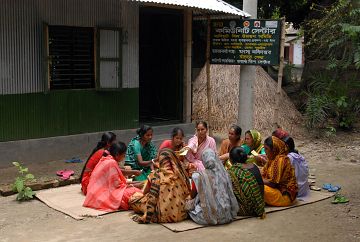Antimicrobial resistance: Tailored storytelling is key to successful community interventions
24 November 2023
In a comment piece published in BMC Research Notes and written on behalf of CE4AMR (Community Engagement for Antimicrobial Resistance) network, a team of collaborators from organisations including Malaria Consortium presents seven key concepts that are integral to changing the human behaviours driving the development of antimicrobial resistance (AMR).
Growing resistance of pathogens (disease-causing microorganisms) to the effects of available antimicrobial medicines is a significant global health problem, both in humans and animals. If allowed to proceed unchecked, it will render useless many of the existing treatments on which we depend to prevent and treat infectious diseases. Bacterial AMR alone contributes to 4.95 million deaths per year — a number that is estimated to rise to 10 million by 2050.
“Human behaviour is driving antimicrobial resistance. Our decision-making processes are often based on emotions and perceptions over health-promoting logic. Tackling AMR therefore requires the use of creative approaches such as storytelling which influence people on an emotional level,” commented Helen Hawkings, Social and Behaviour Change Specialist at Malaria Consortium and member of CE4AMR.
A recent article from the same team, which was published in JAC-Antimicrobial Resistance, adds to this body of evidence, providing a framework for the ‘equitable development of contextually appropriate, clearly evidenced behavioural objectives for community engagement interventions’.
While the evolution of AMR is a naturally occurring process, it is exacerbated by the overuse and misuse of antimicrobial medicines, increased availability of poor-quality counterfeit medicines, environmental contamination with drugs, and lack of hygiene and infection control measures. Explaining how microbes are able to move between people, animals, soil and water can facilitate discussions on how communities can work together to identify and reduce the risk of AMR within their specific environments.
Given that the messaging relating to AMR is often complex, the CE4AMR network uses a tailored approach to community engagement, with context-appropriate storytelling that community members can relate to. This storytelling approach, identified from across different CE4AMR projects in southeast Asia, could be used to inform future community-level social and behaviour change interventions that aim to tackle AMR through community engagement.
The CE4AMR network is an international interdisciplinary network established in 2019 with the aim of tackling the behavioural drivers of AMR at the community level, mainly in low-middle income countries (LMICs) within southeast Asia such as Nepal and Bangladesh, where overuse of antimicrobials is common and many people are unaware of the dangers of AMR. Malaria Consortium has been a part of the network since its inception. As an organisation dedicated to tackling the effects of preventable and treatable communicable diseases on communities, we are concerned about the impact of AMR on public health, including on ongoing malaria control and elimination efforts.
The network includes research projects such as the COSTAR collaboration, in which Malaria Consortium and partner organisations are taking a ‘One Health’ approach to identify optimal community-led strategies for tackling AMR. While more people in LMICs are currently dying from a lack of access to appropriate treatment than from AMR, this is likely to change unless a One Health approach and strong coordination mechanisms are fully embedded at local, national and global levels. The One Health approach promotes collaboration between stakeholders working in human, animal and environmental health sectors. This approach was endorsed in 2015 by the World Health Organization, the Food and Agricultural Organization and the World Organization for Animal Health.
For more information about the COSTAR project, read our Project Brief
Photo by Khaled Sattar
Latest news
- Malaria Consortium honoured by Ugandan government for contribution to combat malaria23rd April 2024
- International summit calls for AMR accountability in public health interventions21st March 2024
- Global SMC community celebrates new milestone at SMC Alliance Annual Meeting in Nigeria6th March 2024
- Scaling up key interventions could halve pneumonia-related childhood mortality13th February 2024
- Malaria Consortium and eGov Foundation join Mozambique’s national malaria programme to digitalise seasonal malaria chemoprevention campaigns8th February 2024
- World’s first malaria vaccine rollout launched in Cameroon22nd January 2024